CADILLAC ESCALADE 2011 3.G Owners Manual
Manufacturer: CADILLAC, Model Year: 2011, Model line: ESCALADE, Model: CADILLAC ESCALADE 2011 3.GPages: 558, PDF Size: 7.59 MB
Page 121 of 558
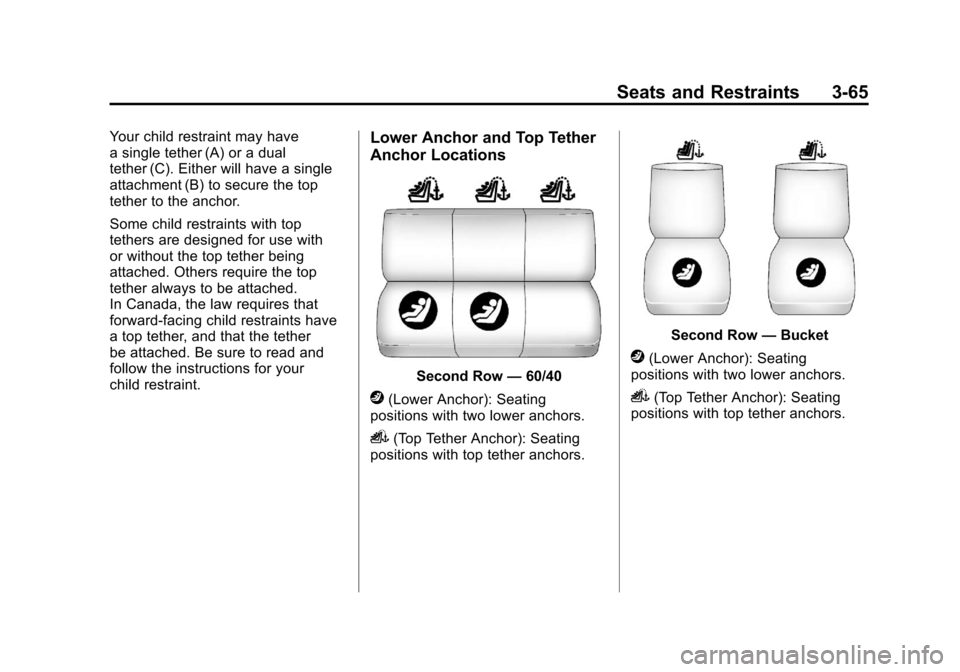
Black plate (65,1)Cadillac Escalade/Escalade ESV Owner Manual - 2011
Seats and Restraints 3-65
Your child restraint may have
a single tether (A) or a dual
tether (C). Either will have a single
attachment (B) to secure the top
tether to the anchor.
Some child restraints with top
tethers are designed for use with
or without the top tether being
attached. Others require the top
tether always to be attached.
In Canada, the law requires that
forward-facing child restraints have
a top tether, and that the tether
be attached. Be sure to read and
follow the instructions for your
child restraint.Lower Anchor and Top Tether
Anchor Locations
Second Row—60/40
j(Lower Anchor): Seating
positions with two lower anchors.
i(Top Tether Anchor): Seating
positions with top tether anchors.
Second Row —Bucket
j(Lower Anchor): Seating
positions with two lower anchors.
i(Top Tether Anchor): Seating
positions with top tether anchors.
Page 122 of 558
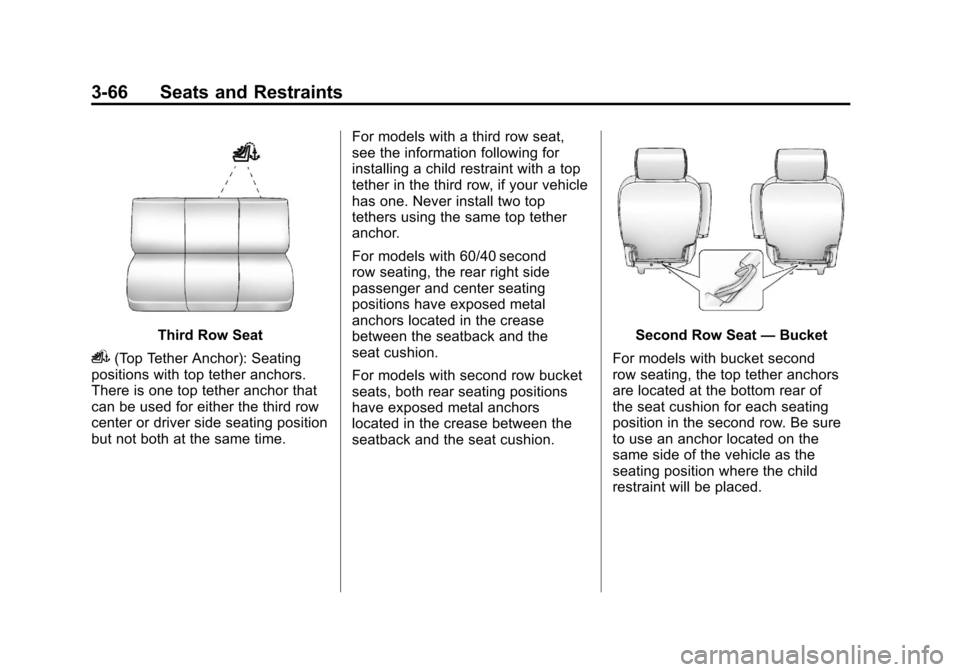
Black plate (66,1)Cadillac Escalade/Escalade ESV Owner Manual - 2011
3-66 Seats and Restraints
Third Row Seat
i(Top Tether Anchor): Seating
positions with top tether anchors.
There is one top tether anchor that
can be used for either the third row
center or driver side seating position
but not both at the same time. For models with a third row seat,
see the information following for
installing a child restraint with a top
tether in the third row, if your vehicle
has one. Never install two top
tethers using the same top tether
anchor.
For models with 60/40 second
row seating, the rear right side
passenger and center seating
positions have exposed metal
anchors located in the crease
between the seatback and the
seat cushion.
For models with second row bucket
seats, both rear seating positions
have exposed metal anchors
located in the crease between the
seatback and the seat cushion.
Second Row Seat
—Bucket
For models with bucket second
row seating, the top tether anchors
are located at the bottom rear of
the seat cushion for each seating
position in the second row. Be sure
to use an anchor located on the
same side of the vehicle as the
seating position where the child
restraint will be placed.
Page 123 of 558
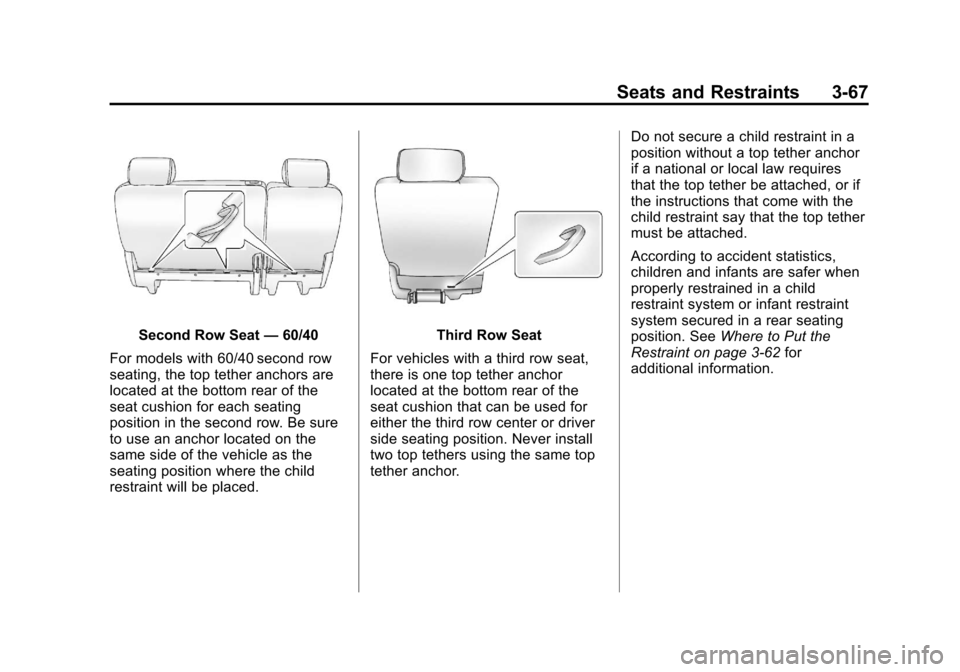
Black plate (67,1)Cadillac Escalade/Escalade ESV Owner Manual - 2011
Seats and Restraints 3-67
Second Row Seat—60/40
For models with 60/40 second row
seating, the top tether anchors are
located at the bottom rear of the
seat cushion for each seating
position in the second row. Be sure
to use an anchor located on the
same side of the vehicle as the
seating position where the child
restraint will be placed.Third Row Seat
For vehicles with a third row seat,
there is one top tether anchor
located at the bottom rear of the
seat cushion that can be used for
either the third row center or driver
side seating position. Never install
two top tethers using the same top
tether anchor. Do not secure a child restraint in a
position without a top tether anchor
if a national or local law requires
that the top tether be attached, or if
the instructions that come with the
child restraint say that the top tether
must be attached.
According to accident statistics,
children and infants are safer when
properly restrained in a child
restraint system or infant restraint
system secured in a rear seating
position. See
Where to Put the
Restraint on page 3‑62 for
additional information.
Page 124 of 558
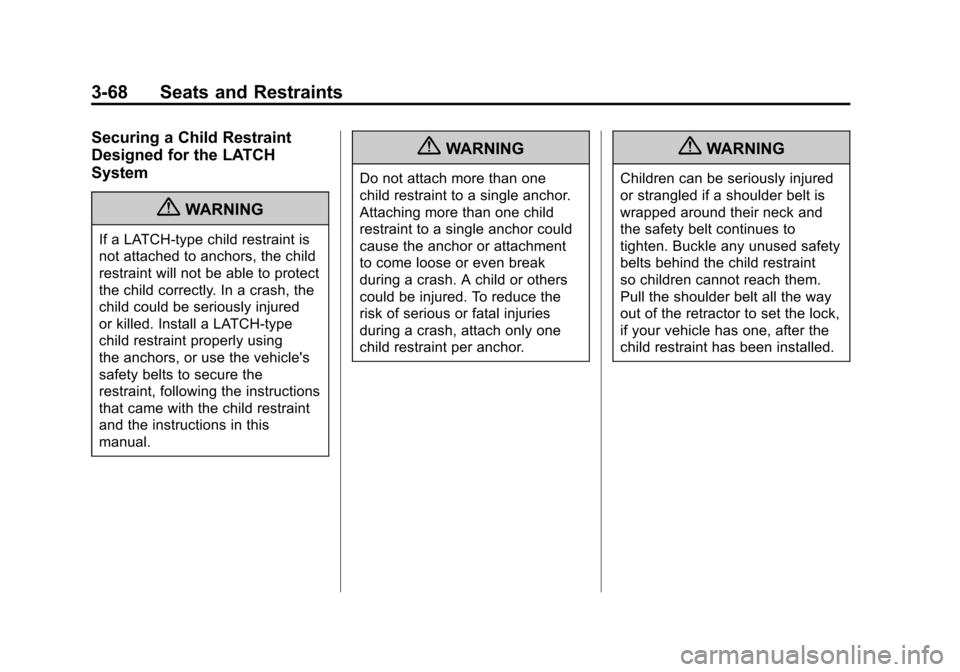
Black plate (68,1)Cadillac Escalade/Escalade ESV Owner Manual - 2011
3-68 Seats and Restraints
Securing a Child Restraint
Designed for the LATCH
System
{WARNING
If a LATCH-type child restraint is
not attached to anchors, the child
restraint will not be able to protect
the child correctly. In a crash, the
child could be seriously injured
or killed. Install a LATCH-type
child restraint properly using
the anchors, or use the vehicle's
safety belts to secure the
restraint, following the instructions
that came with the child restraint
and the instructions in this
manual.
{WARNING
Do not attach more than one
child restraint to a single anchor.
Attaching more than one child
restraint to a single anchor could
cause the anchor or attachment
to come loose or even break
during a crash. A child or others
could be injured. To reduce the
risk of serious or fatal injuries
during a crash, attach only one
child restraint per anchor.
{WARNING
Children can be seriously injured
or strangled if a shoulder belt is
wrapped around their neck and
the safety belt continues to
tighten. Buckle any unused safety
belts behind the child restraint
so children cannot reach them.
Pull the shoulder belt all the way
out of the retractor to set the lock,
if your vehicle has one, after the
child restraint has been installed.
Page 125 of 558
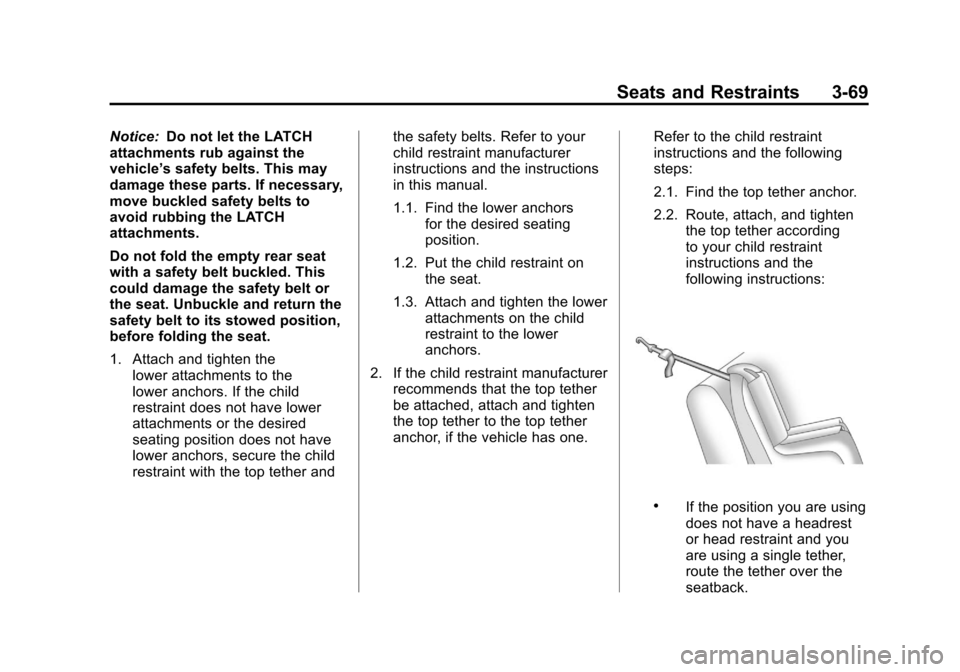
Black plate (69,1)Cadillac Escalade/Escalade ESV Owner Manual - 2011
Seats and Restraints 3-69
Notice:Do not let the LATCH
attachments rub against the
vehicle’ s safety belts. This may
damage these parts. If necessary,
move buckled safety belts to
avoid rubbing the LATCH
attachments.
Do not fold the empty rear seat
with a safety belt buckled. This
could damage the safety belt or
the seat. Unbuckle and return the
safety belt to its stowed position,
before folding the seat.
1. Attach and tighten the lower attachments to the
lower anchors. If the child
restraint does not have lower
attachments or the desired
seating position does not have
lower anchors, secure the child
restraint with the top tether and the safety belts. Refer to your
child restraint manufacturer
instructions and the instructions
in this manual.
1.1. Find the lower anchors
for the desired seating
position.
1.2. Put the child restraint on the seat.
1.3. Attach and tighten the lower attachments on the child
restraint to the lower
anchors.
2. If the child restraint manufacturer recommends that the top tether
be attached, attach and tighten
the top tether to the top tether
anchor, if the vehicle has one. Refer to the child restraint
instructions and the following
steps:
2.1. Find the top tether anchor.
2.2. Route, attach, and tighten
the top tether according
to your child restraint
instructions and the
following instructions:
.If the position you are using
does not have a headrest
or head restraint and you
are using a single tether,
route the tether over the
seatback.
Page 126 of 558
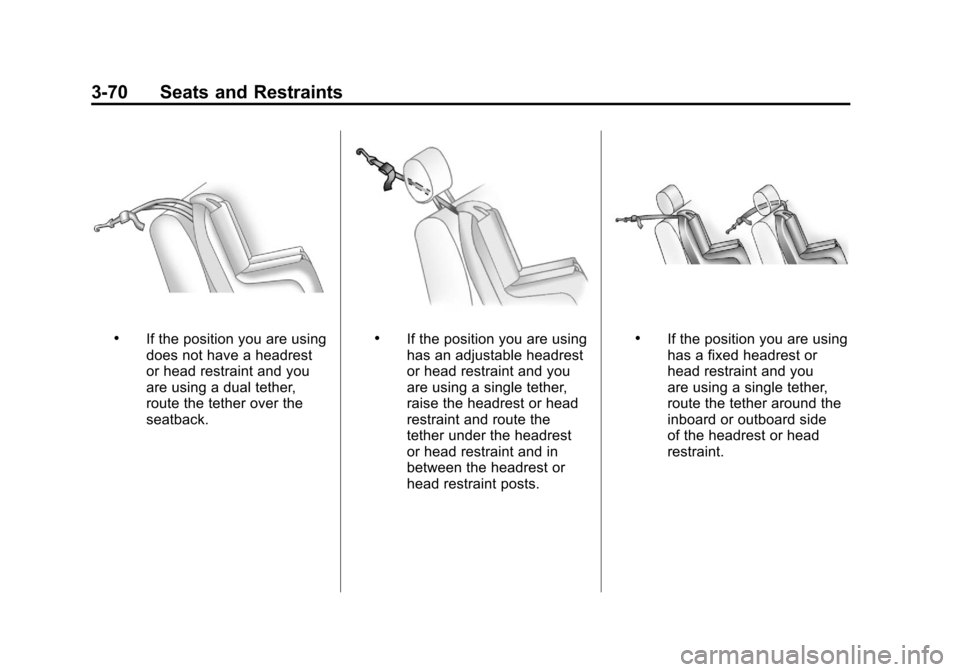
Black plate (70,1)Cadillac Escalade/Escalade ESV Owner Manual - 2011
3-70 Seats and Restraints
.If the position you are using
does not have a headrest
or head restraint and you
are using a dual tether,
route the tether over the
seatback..If the position you are using
has an adjustable headrest
or head restraint and you
are using a single tether,
raise the headrest or head
restraint and route the
tether under the headrest
or head restraint and in
between the headrest or
head restraint posts..If the position you are using
has a fixed headrest or
head restraint and you
are using a single tether,
route the tether around the
inboard or outboard side
of the headrest or head
restraint.
Page 127 of 558
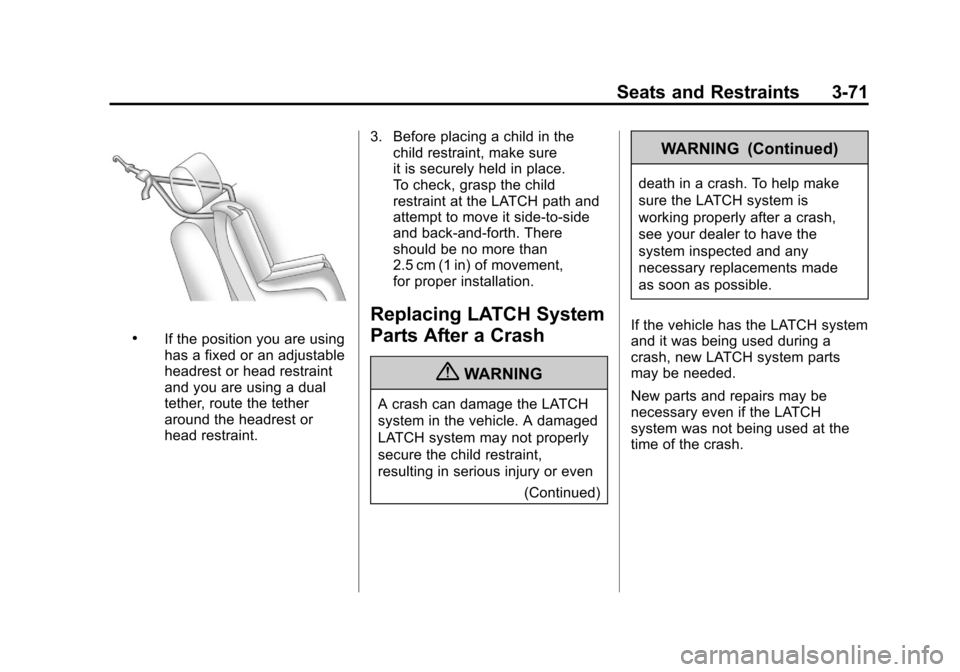
Black plate (71,1)Cadillac Escalade/Escalade ESV Owner Manual - 2011
Seats and Restraints 3-71
.If the position you are using
has a fixed or an adjustable
headrest or head restraint
and you are using a dual
tether, route the tether
around the headrest or
head restraint.3. Before placing a child in the
child restraint, make sure
it is securely held in place.
To check, grasp the child
restraint at the LATCH path and
attempt to move it side‐to‐side
and back‐and‐forth. There
should be no more than
2.5 cm (1 in) of movement,
for proper installation.
Replacing LATCH System
Parts After a Crash
{WARNING
A crash can damage the LATCH
system in the vehicle. A damaged
LATCH system may not properly
secure the child restraint,
resulting in serious injury or even
(Continued)
WARNING (Continued)
death in a crash. To help make
sure the LATCH system is
working properly after a crash,
see your dealer to have the
system inspected and any
necessary replacements made
as soon as possible.
If the vehicle has the LATCH system
and it was being used during a
crash, new LATCH system parts
may be needed.
New parts and repairs may be
necessary even if the LATCH
system was not being used at the
time of the crash.
Page 128 of 558

Black plate (72,1)Cadillac Escalade/Escalade ESV Owner Manual - 2011
3-72 Seats and Restraints
Securing Child Restraints
(Rear Seat Position)
When securing a child restraint in
a rear seating position, study the
instructions that came with the
child restraint to make sure it is
compatible with this vehicle.
If the child restraint has the LATCH
system, seeLower Anchors and
Tethers for Children (LATCH
System) on page 3‑63 for how and
where to install the child restraint
using LATCH. If a child restraint
is secured in the vehicle using a
safety belt and it uses a top tether,
see Lower Anchors and Tethers
for Children (LATCH System) on
page 3‑63 for top tether anchor
locations. Do not secure a child seat in a
position without a top tether anchor
if a national or local law requires
that the top tether be anchored, or if
the instructions that come with the
child restraint say that the top strap
must be anchored.
In Canada, the law requires that
forward-facing child restraints have
a top tether, and that the tether be
attached.
If the child restraint does not have
the LATCH system, you will be
using the safety belt to secure
the child restraint in this position.
Be sure to follow the instructions
that came with the child restraint.
Secure the child in the child restraint
when and as the instructions say.
If more than one child restraint
needs to be installed in the rear
seat, be sure to read
Where to Put
the Restraint on page 3‑62.
The vehicle's lap‐shoulder belts
for the first and second row
seating positions are equipped
with free‐falling latch plates.
If the vehicle has a third row, the
lap‐shoulder belts have either
free‐falling or cinching latch plates.
Page 129 of 558
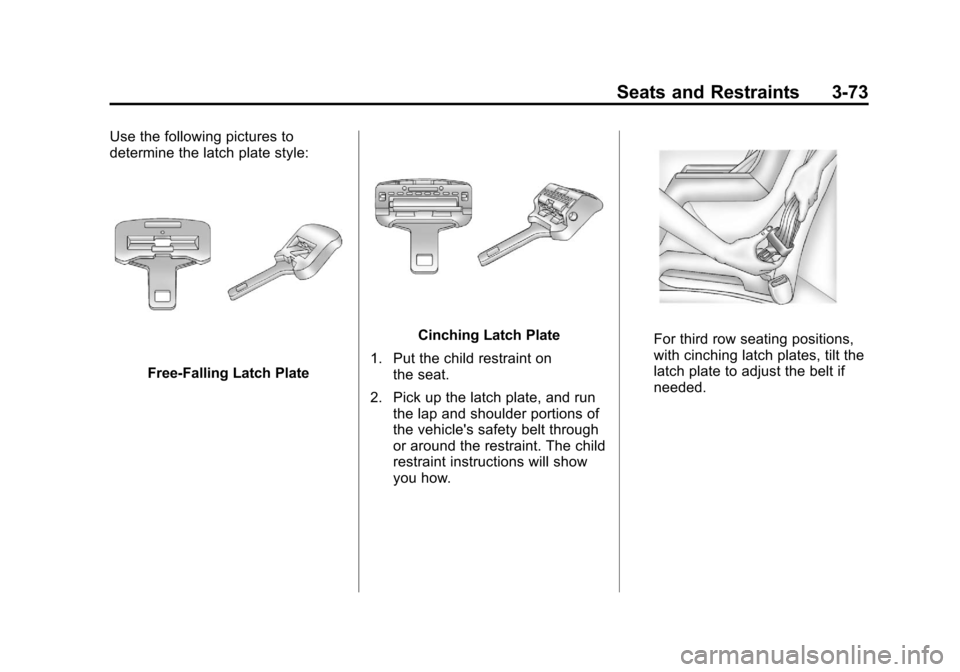
Black plate (73,1)Cadillac Escalade/Escalade ESV Owner Manual - 2011
Seats and Restraints 3-73
Use the following pictures to
determine the latch plate style:
Free‐Falling Latch Plate
Cinching Latch Plate
1. Put the child restraint on the seat.
2. Pick up the latch plate, and run the lap and shoulder portions of
the vehicle's safety belt through
or around the restraint. The child
restraint instructions will show
you how.For third row seating positions,
with cinching latch plates, tilt the
latch plate to adjust the belt if
needed.
Page 130 of 558
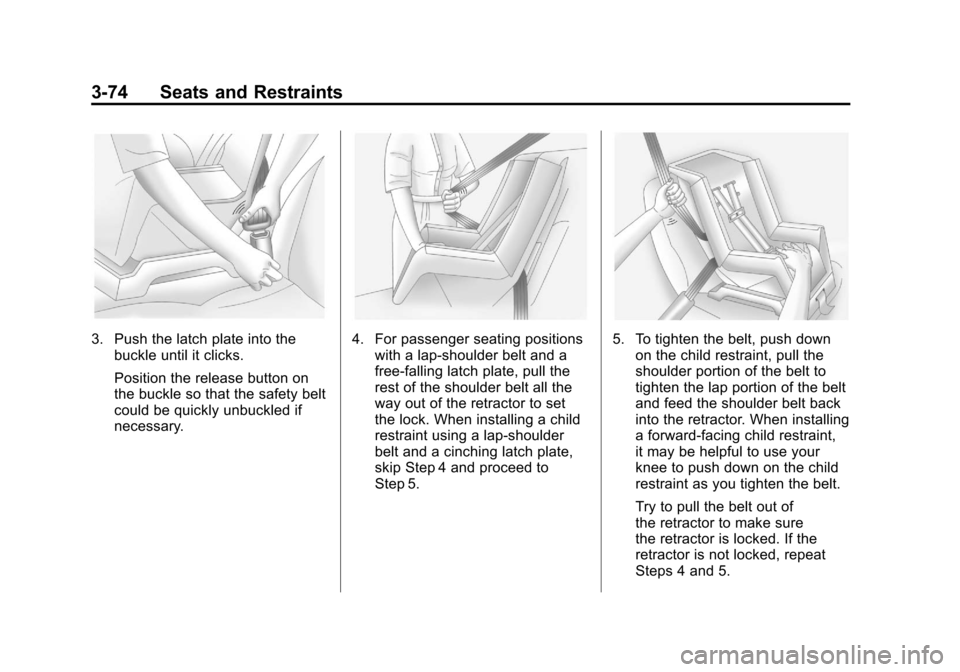
Black plate (74,1)Cadillac Escalade/Escalade ESV Owner Manual - 2011
3-74 Seats and Restraints
3. Push the latch plate into thebuckle until it clicks.
Position the release button on
the buckle so that the safety belt
could be quickly unbuckled if
necessary.4. For passenger seating positionswith a lap‐shoulder belt and a
free‐falling latch plate, pull the
rest of the shoulder belt all the
way out of the retractor to set
the lock. When installing a child
restraint using a lap‐shoulder
belt and a cinching latch plate,
skip Step 4 and proceed to
Step 5.5. To tighten the belt, push downon the child restraint, pull the
shoulder portion of the belt to
tighten the lap portion of the belt
and feed the shoulder belt back
into the retractor. When installing
a forward-facing child restraint,
it may be helpful to use your
knee to push down on the child
restraint as you tighten the belt.
Try to pull the belt out of
the retractor to make sure
the retractor is locked. If the
retractor is not locked, repeat
Steps 4 and 5.